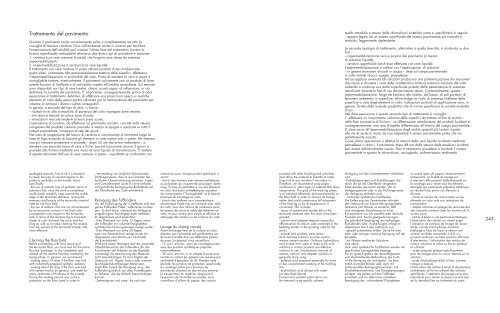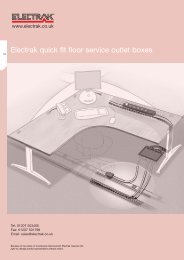by Stone & Sannini - EKA Group
by Stone & Sannini - EKA Group
by Stone & Sannini - EKA Group
You also want an ePaper? Increase the reach of your titles
YUMPU automatically turns print PDFs into web optimized ePapers that Google loves.
Trattamento del pavimento<br />
Quando il pavimento risulta accuratamente pulito e completamente asciutto (si<br />
consiglia di lasciare circolare l’aria nell’ambiente anche in inverno per facilitare<br />
l’evaporazione dell’umidità) può iniziare l’ultima fase del trattamento (ovvero la<br />
finitura superficiale) realizzabile attraverso due diversi tipi di procedure e sostanze:<br />
1. ceratura (con cere cremose in pasta) che fungono esse stesse da sostanze<br />
impermeabilizzanti;<br />
2. impermeabilizzazione e ceratura (con cere liquide).<br />
Il trattamento con cere cremose in pasta utilizza prodotti di tipo tradizionale;<br />
questi ultimi, unitamente alla personalizzazione estetica delle superfici, effettuano<br />
l’impermeabilizzazione in profondità del cotto. Prima di stendere la cera in pasta è<br />
consigliabile trattare, eventualmente, il pavimento unicamente con un prodotto di base<br />
avente funzioni di livellante e di antirisalita rispetto all’umidità ascendente. Sul mercato<br />
sono disponibili vari tipi di cere (neutre, chiare, scure) capaci di influenzare, in via<br />
definitiva, la tonalità del pavimento. E’ importante, conseguentemente, prima di dare<br />
esecuzione al trattamento definitivo, di effettuare una prova fuori opera su qualche<br />
elemento di cotto della stessa partita utilizzata per la realizzazione del pavimento per<br />
valutare in anticipo i diversi risultati conseguibili.<br />
In genere, a secondo del tipo di cera, si hanno:<br />
-- risultati vicini alla cromaticità di partenza del cotto impiegato (cere neutre);<br />
-- toni tenui e naturali di colore (cere chiare);<br />
-- intonazioni marcate tendenti al moro (cere scure).<br />
L’operazione di ceratura, da effettuarsi sul pavimento asciutto, consiste nella stesura<br />
omogenea del prodotto cremoso prescelto a mezzo di spugne o spazzole su tutto il<br />
campo pavimentale, compresa la rete dei giunti.<br />
Nel caso di sospensione del lavoro di ceratura si raccomanda di terminare lungo le<br />
linee di fuga evitando di lasciare gli elementi in cotto trattati solo in parte. Per ottenere<br />
una più marcata protezione si procede -- dopo 24 ore dal primo trattamento -- a<br />
stendere una seconda mano di cera a finire. Lasciati trascorrere ancora 2 giorni si<br />
procede alla finitura mediante una mano di cera liquida di manutenzione. Il risultato<br />
d’aspetto derivante dall’uso di cere cremose in pasta -- soprattutto se confrontato con<br />
packaged mixtures, first of all it is essential<br />
to check the type of use that applies to the<br />
products available on the market. More<br />
specifically:<br />
- the use of sealants free of synthetic resins or<br />
polymers that, once the work is completed,<br />
could create unsightly rings around the visible<br />
edge of the terracotta elements, ruining the<br />
evenness and beauty of the terracotta material<br />
used for the floor field;<br />
- the use of sealants that are not characterized<br />
<strong>by</strong> an excessive contrast in the final color<br />
arrangement with respect to the terracotta,<br />
both in terms of the maintaining a consistent<br />
shade of color between the joints and the<br />
tiling as well as to make cleaning the residue<br />
from the surface of the terracotta simpler and<br />
more effective.<br />
Cleaning the floor field<br />
Before proceeding with final cleaning of<br />
the terracotta floor, you must wait for the entire<br />
flooring “package” to dry completely and<br />
release all the relative humidity created <strong>by</strong> the<br />
laying phase. In general, we recommend:<br />
- waiting about 15 days if the floor was laid<br />
with industrially-prepared synthetic sealants;<br />
- waiting about 30 days if the floor was laid<br />
with cement mortar (in general, one week for<br />
every centimeter of thickness of the screed).<br />
During this waiting period, any surface<br />
protection on the floor (used in order to<br />
- Verwendung von möglichst farbneutralen<br />
Dichtungsmassen; dies ist aus Gründen der<br />
farblichen Übereinstimmung zwischen Fugen<br />
und Cottoelementen sowie für eine einfache<br />
und gründliche Reinigung der Rückstände auf<br />
der Oberfläche des Cotto erforderlich.<br />
Reinigung des Fußbodens<br />
Vor der Endreinigung der Cottofläche muß das<br />
ganze Fußboden-”Paket” vollkommen trocken<br />
sein. Es darf keine, während der Verlegung<br />
eingedrungene Feuchtigkeit mehr enthalten.<br />
Im allgemeinen wird empfohlen:<br />
- Eine Wartezeit von zirka 15 Tagen, wenn<br />
der Fußboden mit industriell hergestellten<br />
synthetischen Dichtungsmassen verlegt wurde.<br />
- Eine Wartezeit von zirka 30 Tagen,<br />
wenn mit Zementmörtel verlegt wurde (im<br />
allgemeinen eine Woche pro Zentimeter<br />
der Estrichstärke).<br />
Während dieser Wartezeit darf der eventuelle<br />
Oberflächenschutz des Fußbodens (für das<br />
Fortschreiten der Arbeiten an der Baustelle<br />
notwendig) die Abtrocknung des Materials<br />
nicht beeinträchtigen. Es wird folglich der<br />
Gebrauch von Papier, Karton oder anderen<br />
feuchtigskeitsdurchlässigen Materialien<br />
empfohlen.Zweck der Reinigung ist es, den<br />
Fußboden gründlich von allen Fremdkörpern<br />
zu befreien, die die Ästhetik beeinträchtigen<br />
können:<br />
- Zementspuren und -reste, die nach der<br />
instructions pour chaque produit spécifique; à<br />
savoir:<br />
- choisir des mortiers sans résines synthétiques<br />
ou polymères qui risquent de provoquer, après<br />
coup, le long du périmètre à vue des éléments<br />
en cotto, des halos antiesthétiques capables<br />
de compromettre l’”homogénéité” et la beauté<br />
plastique du carrelage en cotto;<br />
- choisir des scellants sans caractéristique<br />
chromatique finale trop en contraste avec celle<br />
du cotto, pour des raisons de cohérence entre<br />
les teintes des joints et celles des éléments en<br />
cotto, et pour rendre plus simple et efficace le<br />
nettoyage des résidus sur les surfaces du cotto.<br />
Lavage du champ carrelé<br />
Avant nettoyage final de la surface en cotto,<br />
attendre que l’ensemble soit parfaitement sec<br />
de toute humidité due aux différentes phases<br />
de pose. En général, nous conseillons:<br />
- 15 jours, environ, pour les carrelages posés<br />
avec des produits synthétiques préparés<br />
industriellement;<br />
- 30 jours, environ, si on adopte la pose avec<br />
mortier au ciment (en général une semaine par<br />
centimètre d’épaisseur du lit). Pendant cette<br />
période, les produits de protection superficielle<br />
du carrelage (utiles pour favoriser les<br />
activités de chantier) ne devront pas entraver<br />
la transpiration du matériau nécessaire à<br />
l’expulsion de l’humidité accumulée; nous<br />
conseillons d’utiliser du papier, des cartons<br />
proceed with other building-yard activities)<br />
must allow the material to breathe in order<br />
to get rid of any moisture it has taken in.<br />
Therefore, we recommend using paper,<br />
cardboard or other types of material that allow<br />
transpiration. The goal of the washing phase<br />
is to intervene effectively (and permanently) on<br />
the floor field in order to remove all foreign<br />
matter that could compromise full enjoyment<br />
of the flooring as far as appearance is<br />
concerned. This includes:<br />
- traces of cement and residue left on the<br />
terracotta elements after the joints have been<br />
grouted;<br />
- calcium and saltpeter deposits caused <strong>by</strong><br />
efflorescence of calcium salts contained in the<br />
bedding mortar or the grouting used for the<br />
joints;<br />
- enamel and synthetic paint stains.<br />
Acid cleaning solutions must be used to<br />
remove cement residue. Ordinary hydrochloric<br />
acid (mixed with water to make a 6% acid<br />
solution) or similar products are effective<br />
solutions to use. Simultaneous removal of<br />
cement, calcium and saltpeter residues is<br />
generally done using:<br />
- buffered acid prepared especially for more<br />
or less concentrated washing at the building<br />
site;<br />
- hydrochloric acid diluted with water<br />
(as described above).<br />
Enamel and synthetic paint stains can<br />
be removed using specific solvents.<br />
quello ottenibile a mezzo delle idromulsioni sintetiche come si specificherà in seguito<br />
-- appare legato ad un assetto superficiale del campo pavimentale più naturale e<br />
morbido, leggermente risplendente.<br />
La seconda tipologia di trattamento, alternativa a quella descritta, è strutturata su due<br />
fasi:<br />
-- impermeabilizzazione vera e propria del pavimento (a mezzo<br />
di soluzioni liquide);<br />
-- ceratura superficiale (anch’essa effettuata con cere liquide).<br />
L’impermeabilizzazione si ottiene con l’applicazione di soluzioni<br />
-- in genere monomeri disciolti in acqua -- stese sul campo pavimentale<br />
in cotto tramite stracci, spugne, pennellesse.<br />
Ad asciugatura avvenuta tali soluzioni producono una polimerizzazione dei monomeri<br />
che vanno a chiudere i vuoti della caratteristica struttura materica vaculare del cotto<br />
andando a costituire uno strato superficiale protetto dalla penetrazione di sostanze<br />
macchianti durante le fasi di uso del pavimento stesso. Contestualmente, questa<br />
impermeabilizzazione, funge da barriera alla risalita, dal basso, di sali portatori di<br />
fenomeni antiestetici in superficie; infine svolge un ruolo di sostanza livellante della<br />
superficie a vista degli elementi in cotto. Indicazioni puntuali di applicazione sono, in<br />
genere, fornite dalle aziende produttrici che di norma specificano le corrette modalità<br />
d’uso.<br />
Nel dare esecuzione a questo secondo tipo di trattamento si consiglia:<br />
1. effettuare un ricoprimento uniforme delle superfici da trattare al fine di evitare --<br />
nella fase successiva di finitura -- un differenziato assorbimento dei prodotti lucidanti e,<br />
conseguentemente, una resa d’aspetto differenziata all’interno del campo pavimentale;<br />
2. dare avvio all’impermeabilizzazione dagli ambiti spaziali più lontani rispetto<br />
alle vie di uscita in modo da non calpestare il campo pavimentale prima che sia<br />
perfettamente asciutto.<br />
Come ultima operazione si effettua la stesura della cera liquida lucidante mediante<br />
pennellessa o stracci. Il pavimento dopo 48 ore dalla stesura delle emulsioni lucidanti<br />
può essere definitivamente vissuto. Non è necessario procedere a lucidare il campo<br />
pavimentale in quanto le idromulsioni, asciugando, polimerizzano restituendo<br />
Verfugung auf den Cottoelementen verblieben<br />
sind.<br />
- Kalkablagerungen und Ausblühungen, die<br />
durch die an die Oberfläche steigenden<br />
Kalziumsalze verursacht werden, die im<br />
Verlegungsmörtel oder in der Dichtungsmasse<br />
der Verfugung enthalten sind,<br />
- Lack-oder synthetische Farbflecken.<br />
Die Entfernung von Zementresten erfordert<br />
den Gebrauch von sauren Reinigungsmitteln;<br />
Salzsäure (mit Wasser so verdünnt, daß<br />
eine reinigende Säurelösung mit einer<br />
Konzentration von 6% entsteht) oder ähnliche<br />
Produkte sind hierzu geeignete Lösungen.<br />
Die gründliche Beseitigung von kalkartigen<br />
Rückständen oder Ausblühungen erfolgt im<br />
allgemeinen durch den Gebrauch von:<br />
- speziell zubereiteter milder Säure für eine<br />
mehr oder weniger intensive Reinigung auf der<br />
Baustelle;<br />
- mit Wasser verdünnter Salzsäure<br />
(wie oben).<br />
Lack- oder synthetische Farbflecken werden mit<br />
spezifischen Lösungsmitteln beseitigt.<br />
Für ein gutes Ergebnis der darauffolgenden<br />
und abschließenden Behandlung des Cotto<br />
ist die Reinigung am wichtigsten. Sie kann<br />
mittels normaler Bürsten oder auch mit<br />
professionellen Reinigungsmaschinen, z.B.<br />
Einscheibenmaschinen, und Flüssigkeitssaugern<br />
erfolgen, die stärker auf den Fußboden<br />
einwirken und vor allem eine schnellere<br />
Beseitigung der vorhandenen Flüssigkeiten<br />
ou autres types de support nécessairement<br />
transpirants. La finalité du lavage est<br />
d’intervenir efficacement (définitivement) sur<br />
le carrelage pour retirer tous les éléments<br />
étrangers qui porteraient préjudice esthétique<br />
au résultat final; parmi ces éléments à<br />
éliminer:<br />
-- traces et résidus de ciment restés sur les<br />
éléments en cotto suite aux opérations de<br />
jointoiement;<br />
-- dépôts calcaires et laitages de remontée des<br />
sels calcaires contenus dans les mortiers du lit<br />
ou des joints;<br />
-- taches d’émail ou de peintures synthétiques.<br />
L’élimination des résidus au ciment exige<br />
l’utilisation de solutions de lavage de nature<br />
acide; l’acide chlorhydrique standard<br />
(mélangé à l’eau de façon à obtenir une<br />
solution acidulée concentrée à 6%) ou<br />
produits similaires sont des solutions efficaces<br />
d’intervention. L’élimination des résidus de<br />
ciment, calcaires et salins se fait en général,<br />
en utilisant:<br />
-- acide tamponé préparé spécifiquement<br />
pour les lavages plus ou moins intenses sur le<br />
chantier;<br />
- acide chlorhydrique dilué à l’eau (comme<br />
indiqué ci-dessus).<br />
L’élimination des taches d’émail et de peintures<br />
synthétiques se fait en utilisant des solvants<br />
spécifiques. L’opération de lavage est la plus<br />
importante pour réussir la phase suivante (qui<br />
est la dernière) liée au traitement du cotto;<br />
243





